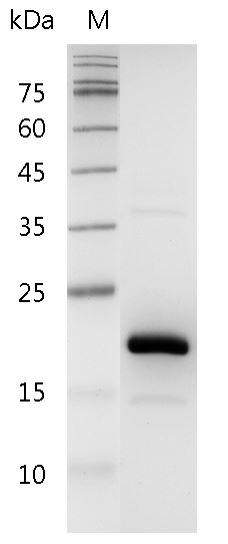| Product name | Human FGF-4 Protein, His tag (Animal-Free) |
| Sequence | Amino acid sequence derived from Human FGF-4 (Gly25-Leu206) (P08620) was expressed with 6×His tag at the C-terminus |
| Applications | His tag |
| Applications notes | Human |
| Protein length | The recombinant Human FGF-4 consists of 182 amino acids and predicts a molecular mass of 20.7 kDa |
| Preparation method | E. coli |
| Purity | >95% as determined by SDS-PAGE. |
| Alternative | HST-1, Transforming protein KS3, HBGF-4 |
| Formulation | Lyophilized from PBS, pH 8.0 |
| Features & Benefits | Endotoxin: <0.1 EU per 1 μg of the protein by the LAL method. |
| Molecular weight | 20.7 kDa |
| Usage notes | Always centrifuge tubes before opening. It is recommended to reconstitute the lyophilized recombinant protein to a concentration of 0.1-1 mg/mL using the buffer we provided, and keep at room temperature for at least 20 min to fully dissolve. Please avoid vortex vigorously |
| Storage instructions | Lyophilized protein product should be stored desiccated below -18°C. Upon reconstitution, the protein should be stored at 4°C between 2-7 days and for future use below -18°C. For long term storage it is recommended to add a carrier protein (5% HSA , 10%FBS or 0.1%BSA). Please prevent freeze-thaw cycles |
| Shipping | Gel pack with blue ice. |
| Precautions | The product listed herein is for research use only and is not intended for use in human or clinical diagnosis. Suggested applications of our products are not recommendations to use our products in violation of any patent or as a license. We cannot be responsible for patent infringements or other violations that may occur with the use of this product. |
| Background | Fibroblast growth factor 4(FGF-4) is a heparin binding member of the FGF family. Mature human FGF4 shares 91%, 82%, 94% and 91% aa identity with mouse, rat, canine and bovine FGF4, respectively. Human FGF-4 has been shown to exhibit cross species activity. Expression of FGF-4 and its receptors, FGF R1c, 2c, 3c and 4, is spatially and temporally regulated during embryonic development. FGF-4 is proposed to play a physiologically relevant role in human embryonic stem cell selfrenewal. It promotes stem cell proliferation, but may also aid differentiation depending on context and concentration, and is often included in embryonic stem cell media in vitro. FGF-4 is mitogenic for fibroblasts and endothelial cells in vitro and has autocrine transforming potential. It is a potent angiogenesis promoter in vivo and has been investigated as therapy for coronary artery disease |
| Alternative | HST-1, Transforming protein KS3, HBGF-4 |
| Accession | P08620 |

You must be logged in to post a review.
Reviews
There are no reviews yet.